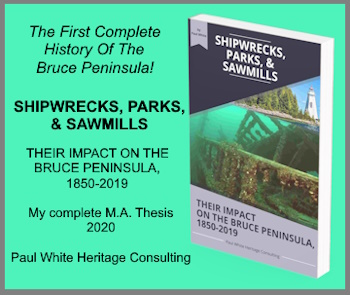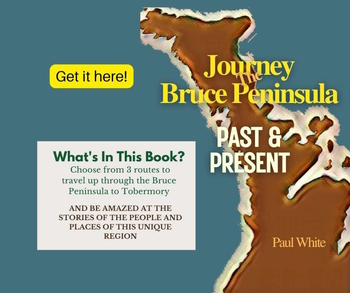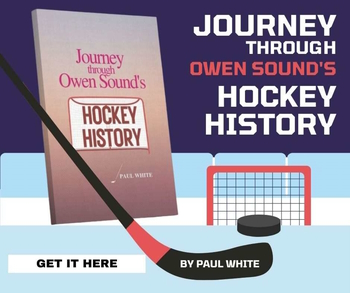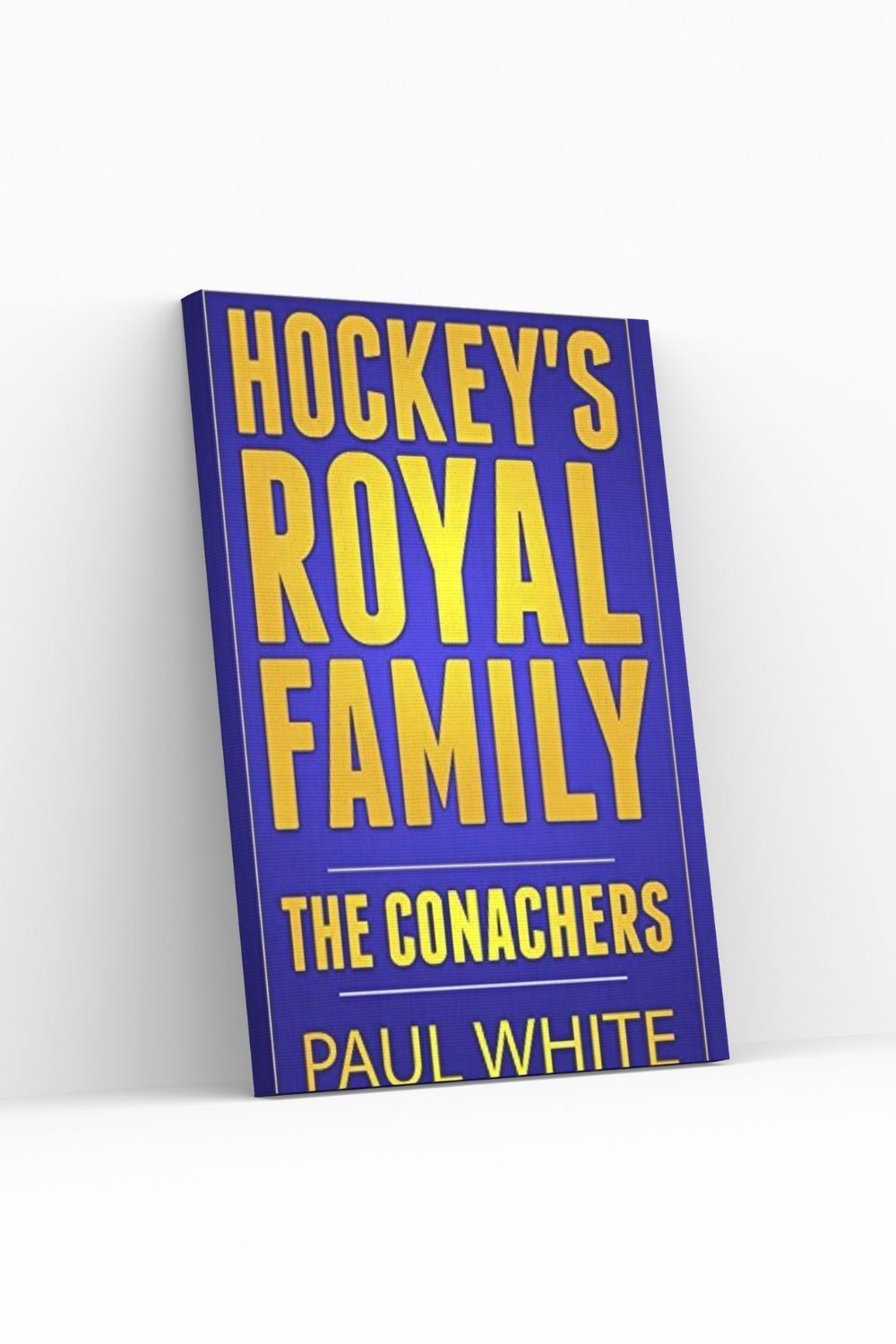Paul Henderson:
A Canadian Hockey Hero
Paul Henderson became a Canadian hockey hero because of a unique childhood experience. Because of this event, he became a hockey player, and, during his career he scored what many consider to be the greatest goal in Canadian hockey history.
Yes, if it were not for an ironic twist of fate in the 1950s, Paul Henderson might not have represented Canada in the historic 1972 Canada – Russia hockey series.
Our story begins in the 1950s when some young boys were playing in the streets of the small village of Lucknow, Ontario when they came to the attention of one of the owners of the local Chinese restaurant. A decade earlier, three brothers Bill, Albert, and George Chin had been the talk of the hockey world. Playing together on a forward line for the Lucknow hockey team they amassed more than half of their team’s point production each season. At one point, both the Detroit Red Wings and the Toronto Maple Leafs were rumoured to be trying to sign the brothers to professional contracts. But for one reason or another, the boys did not play professional hockey and instead went to work at the family’s Chinese restaurant in Lucknow.
When one of the Chin brothers saw Paul Henderson and some of his friends walking down the street in Lucknow, he asked them why they were not playing hockey.
Henderson remembers that after a brief discussion, Albert Chin convinced the boys to go with him into the basement of the Chinese restaurant. There, he put some of his, and his brothers’ hockey equipment on them and taught them some of the points of hockey.
Paul became extremely interested in hockey and he progressed from playing hockey in the basement of the restaurant to minor hockey in the Lucknow area. He rapidly moved up through the ranks of minor hockey gaining attention for his goal scoring abilities. In an 1997 interview in he told me that in one juvenile game he scored 17 or 18 goals.
It was not long before the youngster who learned to play hockey in the basement of a Chinese restaurant signed a contract to play for the Detroit Red Wings junior club, the Hamilton Red Wings
His second season playing for the junior Red Wings was extremely successful as Henderson’s team captured the Memorial Cup.
|
In 1962 his hockey successes continued on a personal level. He notched a league-leading 50 goals in 49 games and was named the OHA Junior loop’s First All-Star right winger. A year later, when Hamilton was knocked out of the junior playoffs, he was called up to play for the Detroit Red Wings. Within another season Paul Henderson was in the NHL. |
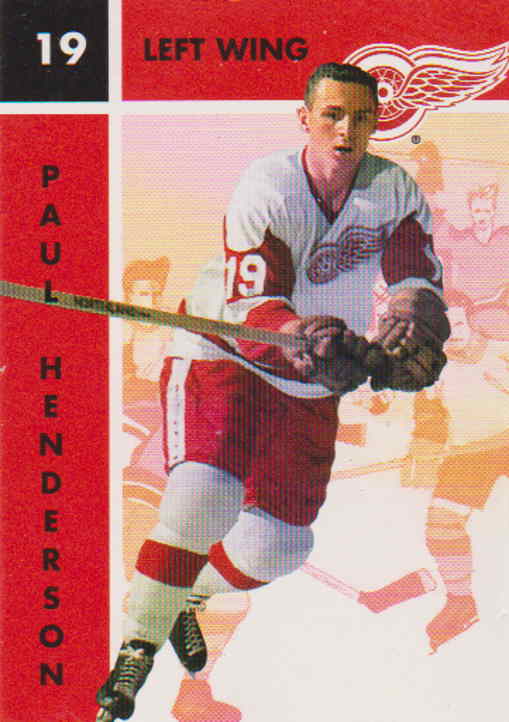 Paul Henderson Detroit Red Wings - Paul White Sports Memorabilia Collection Paul Henderson Detroit Red Wings - Paul White Sports Memorabilia Collection |
After two partial seasons with the Red Wings he played his first full season of NHL hockey during the 1964-65 campaign.
Four seasons after he made his full-time debut as a Red Wing, Paul was part of hockey trade that shook the NHL.
On March 3, 1968 the Detroit Red Wings and the Toronto Maple Leafs announced a trade. This was no ordinary hockey swap. Detroit sent Henderson, Floyd Smith, Doug Barrie and future Hall of Famer Norm Ullman to the Maple Leafs for Garry Unger, Peter Stemkowski, Carl Brewer and future Hall of Famer Frank Mahovlich.
|
It was as a Leaf player that Henderson improved his goal scoring numbers. In four seasons in the "Motor City" he averaged 16 goals each campaign. While skating with the Leafs he increased his goal scoring prowess to an average of more than 25 goals per season. His best season was 1971-72 when he notched 38 goals. |
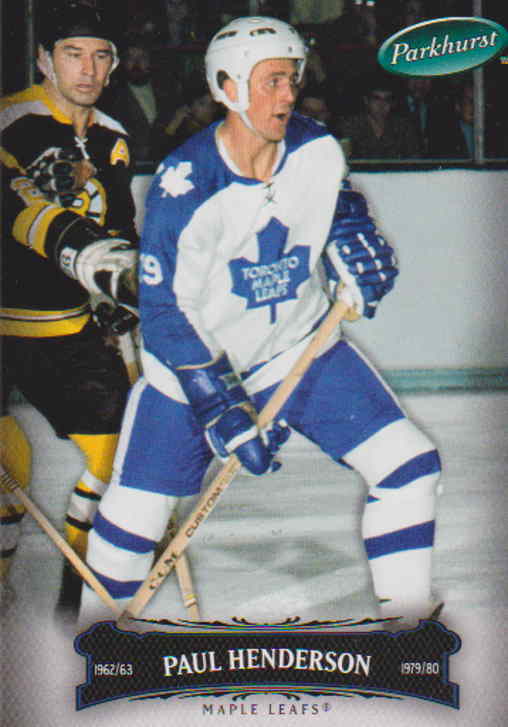 Paul Henderson Toronto Maple Leafs - Paul White Sports Memorabilia Collection Paul Henderson Toronto Maple Leafs - Paul White Sports Memorabilia Collection |
Henderson was known as “Holler Guy”. Jacques Plante told writer Stan Fischler in an interview for an article “Hollerin’ Paul Henderson”, in the May 1972 edition of Hockey Illustrated, that was the reason that Henderson got so many breakaways was because “He yells for the puck. When he gets a break between two defensemen he’ll shout for the puck and his linemen will throw it to him.”
Although he was a valuable contributor to the Red Wings and the Leafs, Paul Henderson will always be remembered for his scoring feats in the 1972 Canada – Russia Summit Series.
When he was chosen to attend the training camp for the Canadian team Paul remembers how everything evolved for him before the series even began.
He remembered that “they put Ron Ellis and I with Bobby Clarke. We got together and we realized that they were probably counting on us to be the last line and we decided “Let’s show them!” We worked our butts off. We could skate and Bobby was just like a young Norm Ullman (Ellis and Henderson’s linemate with Toronto), maybe a bit more aggressive, so we clicked, and we started beating up on the other lines. In the “Red and White” practice game to get into shape we were just flying. We scored three goals and then our confidence got up. They had to play us. We were the best line in camp.”
Paul Henderson recalled how things went when the faced the Russians for the first time:
“Against the Russians, everybody wanted to hammer them in the first game. We had totally underestimated them. We were so impressed by their skill level. That of course led to some of the best hockey we had ever seen. You never know when opportunity is going to knock and Bobby Clarke, Ron Ellis and I were ready.
Things got really serious quickly and we were the only line that stayed together for all eight games. We were sent out there to shut their big lines down. Not only did we do that, but we scored goals. (Henderson scored seven goals, including the winning goal in each of the last three games.) The best goal I ever scored in my life was the winning goal in the seventh game.”
But Henderson laughs, “But that’s not the one that everyone remembers. I scored six really good goals and the garbage goal is the one that everyone remembers.”
One has to wonder how Canadian hockey history might have been so very different if a Chinese Canadian who loved hockey had not taken the time to introduce the game of hockey to those boys in Lucknow, Ontario on a cold winter day in the 1950s!
A version of this story originally appeared in my Local Sports History column in the Owen Sound Sun Times in 1997.
More Great Hockey History Stories
Syl Apps: A Maple Leafs Icon whose smooth skating HHoF talents make him one of the greatest All-Time hockey players in the history of the NHL. Ironically, before he became a Maple Leaf one NHL general manager decided not to sign him to a contract solely because Apps had aspirations of becoming a minister!
Jean Beliveau, an outstanding hockey player, baseball player, a nice guy who in Quebec City was known as the "Ice Cream Man".
Tommy Burlington: the Greatest North American Never to Play in the NHL captured scoring titles in every league that he played, bringing comparisons to NHL greats.
Alex Faulkner: NHL Pioneer only played one game as a Toronto Maple Leaf, but to hockey fans in Newfoundland it was an important hockey game!
Forbes Kennedy suited up for 13 regular season games and one playoff game as a Toronto Maple Leaf. But a lot can happen in 14 hockey games!
Ted "Teeder" Kennedy a Leafs Legend was almost a member of the Montreal Canadiens but a homesick 16 year-old changed that by leaving Canadiens training camp for home.
Hockey history: Florida details the one-year life of the Tropical Hockey League that entertained fans in the south Florida region in the late 1930s.
Larry Jeffrey started his career as a Red Wing, won a Stanley Cup with Toronto, had a short stint as a Ranger and then retired to the beach in Goderich, Ontario!
Rocket Richard, Montreal Canadiens superstar sniper was a goal-scoring nightmare for goalies especially for one NHL goaltender in particular.
Paul Henderson: A Canadian Hockey Hero, "I scored six really good goals and the garbage goal is the one that everyone remembers.”
W.O.A.A. - Western Ontario Athletic Association was the idea of one man that grew to successfully promote sports in western Ontario.
Hockey history is full of surprises, amazing stories and athletes who never cease to surprise. It is more than just stories about the NHL, it is tales from the minor leagues, the bush leagues, and much more. And, it is not just a Canadian story.
